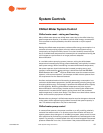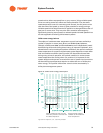
90 Chiller System Design and Control SYS-APM001-EN
System Controls
The flow reduction options include:
• Cooling tower bypass
• Chiller bypass
• One or two throttling valves in the condenser-water pipe with the pump
riding its curve
• A variable-speed condenser water pump
After the minimum-pressure differential is reached, the flow may be
increased as long as that minimum-pressure difference is maintained. Some
designers and operators become concerned with possible fouling of
condenser-water tubes during these start-up conditions. There is little to fear
due to the short duration of reduced flow operation and the limited
occurrences. The advantages and disadvantages of these options are
discussed in a variety of publications.
36,37
Condenser-water temperature control
Cooling-tower-fan control
Cooling towers operate to produce a desired sump water temperature. As the
heat rejection load and ambient wet-bulb temperature change, the cooling
tower fans must move more or less air to produce the desired water
temperature.
Cycling a single fan. Cycling a single fan on and off is one method to
maintain rough water temperature control. Since airflow changes greatly
between fan speeds, so does heat rejection. Temperature swings of 7°F to
10°F [3.9°C to 5.6°C] are not uncommon. Some chillers, especially older
chillers with pneumatic controls, may operate poorly in response to these
changing temperatures. Make sure that the fan does not cycle too often and
damage the motor, drive, or fan assembly.
Two-speed fans. The installation of two-speed cooling tower fans is an
option that reduces temperature swings. Typically, the low fan speed is
between 50 and 70 percent of full speed. Since the heat rejection changes
roughly in proportion with the fan speed, the temperature swing will be only
50 to 75 percent of cycling a single fan. Again, take care not to cycle too often
between speeds—or the gear box may incur excessive wear and fail. A
distinct advantage of two-speed fans is that at low speed, the fan power is
greatly reduced. Since the fan power varies with the cube of the speed
(approximately) the power at half speed is about 15 percent of full speed.
“Pony” motors. Another option offered by cooling-tower manufacturers is to
have two separate motors available to drive the fan. The smaller motor is
referred to as a “pony” motor. It operates at two-thirds of the full speed and
uses about 30 percent of the full speed power. While controlling the tower, it
is important to minimize cycling between speeds.
Variable-speed drives. Because the cost of variable-speed drives for cooling-
tower fans has decreased, variable-speed drives have become more


















